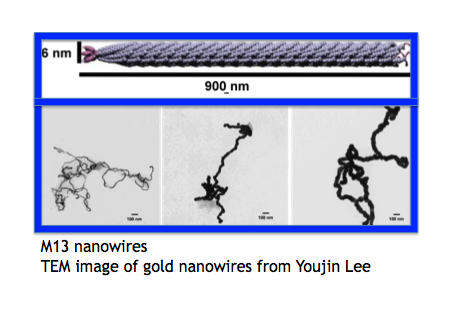20.109(F13):Module 3
Module 3
Instructors: Angela Belcher, Shannon Hughes, Aneesh Ramaswamy, and Agi Stachowiak
TA: Griffin Clausen
“Invention” is a wonderful word, derived from words meaning “scheme” and “a finding out.” Inventors draw on materials provided by the natural world, refining and combining them in insightful ways, to make something useful. In this experimental module we will invent materials by manipulating biological systems, namely the bacteriophage M13. We will use a very slightly modified phage to build Titanium dioxide nanowires and then we'll let the phage themselves do the building, assembling them into a solar cell. Drawing on the rich stockroom of biological elements and a good but incomplete understanding of their behavior, we’ll hope to invent some novel materials with real-world applications.
This module has been developed thanks to the generous time and thoughtful efforts of several Belcher lab members, in particular Xiangnan Dang

Module 3 Goals:
Create a dye-sensitized solar cell containing nanocomposites of either carbon nanotube-TiO2 or gold nanoparticle-TiO2, using engineered M13 bacteriophage as the template to synthesize these materials. Visualize these virus-templated structures using transmission electron microscopy, and assess how the relative amount of carbon nanotubes or gold nanoparticles per phage impacts the efficiency metrics of the assembled solar cell.
Module 3 Experimental Overview:
Two different engineered M13 bacteriophage are used in this module: DSPH, which binds singled-walled carbon nanotubes (SWNTs), and p8#9, which can bind gold nanoparticles (AuNPs). First, DSPH and p8#9 will be isolated from separate infected bacterial cultures by centrifugation and PEG precipitation, and the resulting phage concentrations determined using a spectrophotometer. Each of these phage will be combined with their respective ligand at several different ratios. These complexes will then be coated with biotemplated titanium dioxide, imaged using transmission electron microscopy (TEM), and ultimately ground into a titania paste which will then be incorporated into the dye-sensitized solar cell (DSSC).
Background Links:
- CNN videotape of Angie Belcher teaching President Obama about this work
- Nature Nanotechnology: Virus Templated self-assembled single-walled carbon nanotubes for highly efficient collection in photovoltaic devices
- An animation video of how DSSC's are assembled. Remember, Dr. Belcher's procedure is a little different from what is described here, but it provides a good visual overview.
Lab links: day by day
Day 1: Growth of phage materials
Day 2: Phage nanowires
Day 3: TEM
Day 4: Solar cell assembly
Day 5: Solar cell testing
Day 6: Wrap-up and data summary
Day 7: Research proposal presentations
